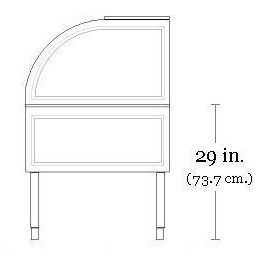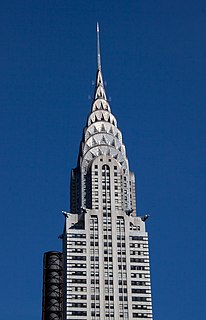
Art Deco, sometimes referred to as Deco, is a style of visual arts, architecture and design that first appeared in France just before World War I. Art Deco influenced the design of buildings, furniture, jewelry, fashion, cars, movie theatres, trains, ocean liners, and everyday objects such as radios and vacuum cleaners. It took its name, short for Arts Décoratifs, from the Exposition internationale des arts décoratifs et industriels modernes held in Paris in 1925. It combined modern styles with fine craftsmanship and rich materials. During its heyday, Art Deco represented luxury, glamour, exuberance, and faith in social and technological progress.

A desk or bureau is a piece of furniture with a flat table-style work surface used in a school, office, home or the like for academic, professional or domestic activities such as reading, writing, or using equipment such as a computer. Desks often have one or more drawers, compartments, or pigeonholes to store items such as office supplies and papers. Desks are usually made of wood or metal, although materials such as glass are sometimes seen.

A rolltop desk is a 19th-century reworking of the pedestal desk with, in addition, a series of stacked compartments, shelves, drawers and nooks in front of the user, much like the bureau à gradin or the Carlton House desk. In contrast to these, the compartments and the desktop surface of a rolltop desk can be covered by means of a tambour consisting of linked wooden slats that roll or slide through slots in the raised sides of the desk. In that, it is a descendant in function, and partly in form, of the cylinder desk of the 18th century. It is a relative of the tambour desk, whose slats retract horizontally rather than vertically. The rolltop desk was re-invented by Jacob Alles in Jasper, Indiana in 1879. "About 1760 Jean-François Oeben designed a new type of bureau: the original rolltop desk. The writing area can be covered by a shutter made of flexible slats, which is rolled round a cylinder hidden behind the top tier of drawers. In the Château de Versailles is found the most famous example of this type of desk, the "bureau du roi," which was begun by Oeben in 1760 and finished by Riesener. Riesener made several rolltop desks; the one for Thierrry de Ville d'Avray indicates that the Louis XV style was not yet regarded as outmoded in the 1780s".
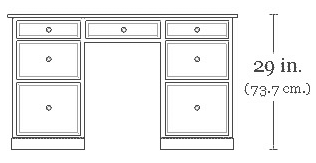
A pedestal desk or a tanker desk is usually a large, flat, free-standing desk made of a simple rectangular working surface resting on two pedestals or small cabinets of stacked drawers of one or two sizes, with plinths around the bases. Often, there is also a central large drawer above the legs and knees of the user. Sometimes, especially in the 19th century and modern examples, a "modesty panel" is placed in front, between the pedestals, to hide the legs and knees of the user from anyone else sitting or standing in front. This variation is sometimes called a "panel desk". The smaller and older pedestal desks with such a panel are sometimes called kneehole desks, and were usually placed against a wall.
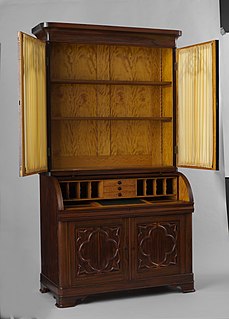
A secretary desk or escritoire is made of a base of wide drawers topped by a desk with a hinged desktop surface, which is in turn topped by a bookcase usually closed with a pair of doors, often made of glass. The whole is usually a single, tall and heavy piece of furniture.

A writing table has a series of drawers directly under the surface of the table, to contain writing implements, so that it may serve as a desk. Antique versions have the usual divisions for the inkwell, the blotter and the sand or powder tray in one of the drawers, and a surface covered with leather or some other material less hostile to the quill or the fountain pen than simple hard wood.

The fall front desk can be considered the cousin of the secretary desk. Both have a main working surface or desktop which does double duty as a cover to seal up papers and other items located in small shelves or small drawers placed one on top of the other in front of the user. Thus, all working papers, documents and other items have to be stored before the desk is closed.

The slant top desk can be considered in some ways as the ancestor or the little brother of the secretary desk for it is, for all practical purposes, a secretary desk without the massive bookcase on top of it. It can also be considered as the descendant, in form, of the desk on a frame, which was a form of portable desk in earlier eras.

There are two kinds of trestle desk: as with trestle tables, some have trestles joined by one or more stretchers, and some have free-standing trestles. They can be dismantled, with the desk top removed from the trestles, for storage or transport.
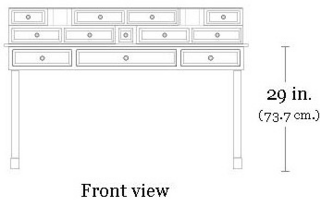
A bureau à gradin is an antique desk form resembling a writing table with, in addition, one or several tiers of small drawers and pigeonholes built on part of the desktop surface. Usually the drawers and pigeonholes directly face the user, but they can also surround three sides of the desk, as is the case for the Carlton house desk form. A small, portable version is a bonheur du jour.

A Carlton House desk is a specific antique desk form within the more general bureau à gradin form. This form of desk is supposed to have been designed in the 18th century for the Prince of Wales by George Hepplewhite. It is named after Carlton House, which was at the time the London residence of the Prince, and sometimes is also known as a Carlton House writing table.
The secretaire en portefeuille is an antique desk form which is usually mounted on rollers at the end of four jutting legs. The legs in turn support what appears as an oversize vertically mounted wooden pizza box. This is a cabinet a few inches thick, with barely enough space in it for the raised desktop surface and a few pens and sheets of paper disposed vertically. It is also called a "Billet doux".

The Bureau du Roi, also known as Louis XV's roll-top desk, is the richly ornamented royal cylinder desk which was constructed at the end of Louis XV's reign, and is now again in the Palace of Versailles.
The desk on a frame is usually an antique form made up of two pieces of furniture. The first piece is a fairly large and closable portable desk with a slanted hinged top giving access to the writing surface and utility nooks and small drawers. The second piece is a stand made for it in the same style and material. It is also sometimes a single piece of furniture which looks as if it were made up of the two previous pieces but is in fact solid and nondetachable. This form was popular in Colonial America and was often done in the Queen Anne style.

Charles-Honoré Lannuier, French cabinetmaker (1779–1819), lived and worked in New York City. In Lannuier's time, the style of his furniture was described as "French Antique." Today his work is classified primarily as Federal furniture, Neoclassical, or American Empire.

Clarence Pearson Hornung was an American trademark and industrial graphic designer and illustrator.

The furniture of the Louis XV period (1715-1774) is characterized by curved forms, lightness, comfort and asymmetry; it replaced the more formal, boxlike and massive furniture of the Style Louis XIV. It employed marquetry, using inlays of exotic woods of different colors, as well as ivory and mother of pearl.

Louis XIV furniture was massive and lavishly covered with sculpture and ornament of gilded bronze in the earlier part of the personal rule of King Louis XIV of France (1660–1690). After about 1690, thanks in large part to the furniture designer André Charles Boulle, a more original and delicate style appeared, sometimes known as Boulle Work. It was based on the use of marquetry, the inlay of piece of ebony and other rare woods, a technique first used in Florence in the 15th century, which was refined and developed by Boulle and others working for the King. Furniture was inlaid with thin plaques of ebony, copper, mother of pearl, and exotic woods of different colors in elaborate designs.

Louis XVI furniture is characterized by elegance and neoclassicism, a return to ancient Greek and Roman models. Much of it was designed and made for Queen Marie Antoinette for the new apartments she created in the Palace of Versailles, Palace of Fontainebleau, the Tuileries Palace, and other royal residences. The finest craftsmen of the time, including Jean-Henri Riesener, Georges Jacob, Martin Carlin, and Jean-François Leleu, were engaged to design and make her furniture.

